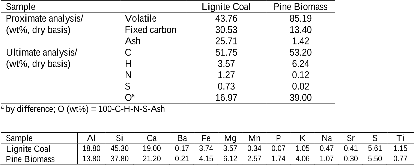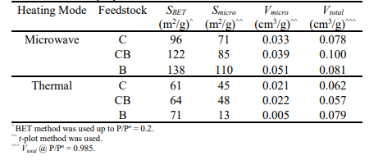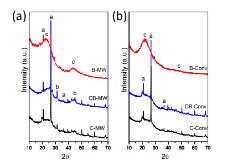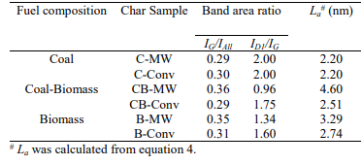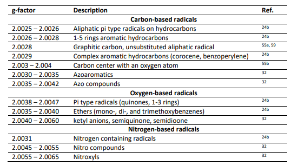Effect of Microwave and Thermal Co-pyrolysis of Low-Rank Coal and Pine Wood on Product Distributions and Char Structure
- National Energy Technology Lab. (NETL), Morgantown, WV (United States); Leidos, Morgantown, WV (United States)
- Univ. of Limerick (Ireland)
- National Energy Technology Lab. (NETL), Morgantown, WV (United States)
Direct conversion of a low-rank coal into valuable chemicals or improving its char’s coking value became very demanding aims in coal utilization strategies. Here, the co-pyrolysis of a low-rank lignite coal and pine wood sawdust biomass blended at a 3:1 coal-to-biomass ratio was investigated along with original coal and biomass samples by microwave-assisted and conventional thermal methods at 550 °C under nitrogen and ambient pressure. The carbon structure and its reactivity in generated chars and the product distributions were greatly affected by the applied heating mechanism and the presence of biomass during coal pyrolysis. High gas and low tar yields were observed for all microwave chars in comparison to thermal chars, regardless of composition. The addition of biomass to coal increased the tar yield under both methods and to a higher extent under the microwave. This agrees with the high gas yield and high aromatic-to-aliphatic fraction observed under the microwave and the presence of biomass. The high O/C ratio and low fixed carbon content in a biomass structure relative to coal affect the product distribution during microwave pyrolysis. This could selectively heat the biomass in the sample, remove its polar groups, and convert it into an efficient microwave absorber biochar that can decompose coal efficiently during co-pyrolysis. The aromatic carbon stacking and its ordering in the generated chars were investigated by powder X-ray diffraction, Raman spectroscopy, dielectric property measurements, and electron spin resonance techniques. A synergistic effect was observed upon biomass addition during microwave coal pyrolysis. Electron spin resonance spectroscopy revealed that the microwave coal/biomass char is the most stable char with the lowest free radical concentration. Furthermore, this agrees with the highest IG/Iall band area ratio calculated from Raman analysis revealing a more graphitic nature for carbon in this char. Similarly, the dielectric properties confirmed that the addition of biomass to coal under the microwave has the highest loss tangent, indicating a high graphitic nature compared to pure biochar or coal char.
- Research Organization:
- National Energy Technology Laboratory (NETL), Pittsburgh, PA, Morgantown, WV, and Albany, OR (United States)
- Sponsoring Organization:
- USDOE National Nuclear Security Administration (NNSA)
- Grant/Contract Number:
- 89243318CFE000003
- OSTI ID:
- 1582379
- Journal Information:
- Energy and Fuels, Vol. 33, Issue 8; ISSN 0887-0624
- Publisher:
- American Chemical Society (ACS)Copyright Statement
- Country of Publication:
- United States
- Language:
- English
Web of Science
Similar Records
Leaching of mixtures of biochar and fly ash
Co-pyrolysis of low rank coals and biomass: Product distributions
